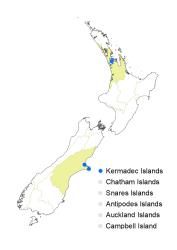- Taxon
- Gallery
Annual herb to 0.1 m tall. Stems spreading to decumbent, hairs of two types: sparse, long, spreading, and uniform, and dense, short, antrorse, and bifarious. Leaf bud indistinct; leaves separating while very small, opposite-decussate, erecto-patent to spreading; lamina thin, lanceolate to ovate, sometimes elliptic or deltoid, 5–10 mm long, 2.2–8.0 mm wide, dull green above, paler beneath, midrib and palmate secondary veins evident; surfaces eglandular-hairy and also some shorter glandular hairs; margin pubescent, serrate; teeth in 3–8 pairs; apex rounded to sub-acute; base truncate; petiole 1–4 mm long. Inflorescence a terminal raceme, 50–150 mm long. Flowers distant, 5–35, all bisexual; bracts alternate, leaf-like, ≥ pedicels; pedicels spreading, 3–6 mm long, up to 12 mm long at fruiting, shortly antrorse pubescent all around with scattered, long, glandular hairs. Calyx lobes 4, acuminate to narrow obtuse apex, sub-equal, 3–4 mm long, enlarging to 6–7 mm at fruiting, with long, glandular hairs on margins, veins and tube. Corolla 4–5 mm diameter; tube white, c. 0.5 mm long, much < calyx, glabrous; lobes 4, white or posterior lobe pale blue to pink, erecto-patent to spreading, unequal, elliptical to broadly elliptical, 2.0–2.5 mm long, rounded; nectar guides pale blue, on posterior lobe. Stamen filaments white, c. 1 mm long; anthers purple. Style glabrous, 0.5–1.0 mm long. Capsules angustiseptate, didymous with faint veins, erect rounded lobes and narrow sinus between, glandular hairy (hairs appearing eglandular on old capsules), 3.0–4.0 mm long, 5.5–7.0 mm at widest point. Seeds ellipsoid, smooth, and deeply concave on funicle side, wrinkled and convex on back, straw-yellow to brown, 1.5–1.8 mm long.
Several species are characterised by a similar growth form of straggly trailing or decumbent stems, with opposite leaves, terminal racemes with alternate leaf-like bracts, and cup-shaped, wrinkled seeds.
V. persica plants have larger, usually blue flowers (8–12 mm diameter, but rarely pale blue or white), lack glandular hairs on pedicels and calyx, although they may have them on the distal half of the capsule, and the capsule is larger, with diverging obtuse lobes and a broad sinus; the style is 1.3–3.0 mm long and extends beyond the capsule sinus. Their capsule valves are conspicuously veined when dry.
Plants of V. polita differ in their calyx having only short, eglandular hairs on the lobe margins, a bright blue corolla with a pale tube and throat, and smaller capsules, which are hairy all over with short, eglandular hairs and a few glandular hairs along the margins. Also, they lack glandular hairs on the pedicels.
Veronica hederifolia plants have a similar growth form but very different appearance; they differ in their bluntly and shallowly 3- to 5-lobed leaves with a large broad terminal lobe, pedicel hairs distinctly in 1 row, calyx lobes plicate at first and cordate at the base, with very long, straight, spreading, eglandular marginal hairs, and few and larger (c. 2.5 mm) seeds.
North Island: Auckland (one early collection from Epsom).
South Island: Canterbury; Kermadec Is. (one early collection).
A very local weed of open disturbed sites, in gardens and waste ground. Recorded elevations range from 0 to 100 m.
Native to Europe and north Africa.
T. Kirk in Hooker (1867, p. 761). Voucher AK 94092, T. Kirk, Epsom.
The Akaroa collection made in February has flowers and mature fruits.
2n = 14 in Europe (Albach et al. 2008).
Veronica agrestis is classified in V. subg. Pocilla (Albach et al. 2004; Albach & Meudt 2010).
V. agrestis is known only from a few early records from Auckland, the Kermadec Is., and Akaroa. Other records are based on specimens now identified as V. persica, V. arvensis, and V. plebeia. The description above is based on a single specimen (CHR 33837, Akaroa, Healy) and the dimensions might not be typical.




